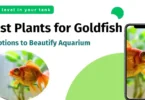Having a vibrant aquarium filled with beautiful aquatic plants is a sight to behold. However, algae growth on aquarium plants is a common challenge that every aquarist faces. Algae not only make the plants look unappealing but also pose a risk to the health of your fish and other aquatic life. In this article, we will delve into the most effective methods to clean algae from aquarium plants, ensuring a thriving and fresh aquatic ecosystem.
How to Clean Algae From Aquarium Plants
Algae can be removed from aquarium plants using various techniques. It’s essential to choose a method that is gentle on the plants while effectively eliminating algae. Here are some practical steps you can follow:
Manual Removal: Manually removing algae is a safe and straightforward method. Use a soft-bristled brush or sponge to gently scrub off the algae from the plant’s leaves and stems. Be cautious not to damage the plants during the process.
Algae Eating Fish
Algae eating refers to organisms or species that consume algae as part of their diet or natural behavior. These organisms play a vital role in maintaining a healthy balance in an aquarium ecosystem by helping to control and reduce algae growth. Examples of algae-eating organisms include certain fish species like Siamese algae eaters and plecos, as well as snails like nerite snails, which are known for their voracious appetite for algae.
Consider adding algae-eating fish, such as Siamese algae eaters or certain species of plecos, to your aquarium. These fish are natural algae consumers and can help control algae growth in plants.
- Introduce Snails: Adding snails like nerite snails can be an effective solution for algae removal. These tiny creatures have a voracious appetite for algae and can help keep your aquarium plants clean.
- Algae Scrapers: Utilize algae scrapers or algae pads specifically designed for aquarium use. These tools allow you to target and remove algae from the plants’ surfaces without causing any harm.
- Chemical Treatments: While chemical treatments should be a last resort, there are algae control products available in the market. Exercise caution when using these chemicals to avoid adverse effects on your plants and aquatic life. Always follow the manufacturer’s instructions.
- Optimize Lighting: Algae thrive in the presence of excessive light. Consider adjusting the lighting duration and intensity to create a balance that promotes plant growth without encouraging algae.
- Regular Water Changes: Performing regular water changes helps in reducing the nutrient buildup that fuels algae growth. Aim for partial water changes every week to maintain water quality and control algae.
- Use Carbon Dioxide (CO2): Maintaining an adequate level of carbon dioxide in your planted aquarium can encourage robust plant growth, making it more challenging for algae to establish.
- Proper Filtration: Invest in a good quality aquarium filter that efficiently removes debris and excess nutrients from the water, thus limiting algae growth.
- Algae-Resistant Plants: Consider adding algae-resistant plants to your aquarium. Some species, like Java fern and Anubias, are less prone to algae growth and can help keep the algae in check.
Homemade algae remover
A “homemade algae remover” refers to a do-it-yourself solution or mixture that is created using household ingredients to effectively remove algae from an aquarium or other surfaces. While there are various recipes and methods available online, it’s essential to exercise caution and ensure that the homemade solution is safe for both the aquatic plants and the fish in the aquarium.
Common homemade algae remover
One common homemade algae remover involves using a vinegar solution. Vinegar, a mild acid, can help break down and dissolve algae, making it easier to clean off surfaces. To create this homemade solution, mix one-part white vinegar with three parts water in a spray bottle. Spray the solution directly onto the affected areas with algae and let it sit for a few minutes. Then, use a soft brush or sponge to gently scrub away the algae. Afterward, rinse the surfaces thoroughly with water to remove any remaining vinegar solution.
Another homemade algae remover includes using hydrogen peroxide. Hydrogen peroxide can effectively kill algae, but it should be used with caution, as it can also harm aquatic plants and fish if not properly diluted. To use hydrogen peroxide as an algae remover, dilute one part hydrogen peroxide with four parts water. Apply the solution carefully to the algae-affected areas and wait for a few minutes before scrubbing and rinsing.
While homemade algae removers can be a cost-effective and accessible option, it’s crucial to research and understand the potential risks and effects on your aquarium’s inhabitants. Always perform a small test in a discrete area before applying the homemade solution to the entire aquarium. Alternatively, you can use commercial algae removers specifically designed for aquarium use, as they are formulated to be safe for aquatic life and more targeted at controlling algae growth.
How do you remove algae from live aquarium plants?
To remove algae from live aquarium plants, you can follow these steps:
- Manual Removal: Gently scrub the algae off the plant’s leaves and stems using a soft brush or sponge. Be careful not to damage the plants during the process.
- Algae-Eating Fish: Introduce algae-eating fish, such as Siamese algae eaters or certain species of plecos, to your aquarium. They will naturally consume the algae on the plants.
- Algae Scrapers: Use algae scrapers or algae pads designed for aquarium use to target and remove algae from plant surfaces without causing harm.
- Snails: Consider adding algae-eating snails like nerite snails, which can help keep your aquarium plants clean.
- Chemical Treatments (Use with Caution): As a last resort, you may use algae control products. However, exercise caution and follow the manufacturer’s instructions to avoid harming your plants and aquatic life.
How do I clean my aquarium plants?
To clean your aquarium plants, you can follow these general steps:
- Remove Plants from the Aquarium: Take the plants out of the aquarium carefully to prevent any damage.
- Gentle Rinse: Gently rinse the plants under running water. Use your fingers to remove any visible debris or algae.
- Inspect for Pests: Check the plants for any signs of pests, and if you find any, isolate the affected plants to prevent infestation.
- Trim Dead Leaves: Trim any dead or decaying leaves to maintain the overall health of the plants.
- Sanitize if Necessary: If you suspect any contamination or disease, you can dip the plants in a diluted bleach solution for a short time, followed by a thorough rinse.
- Reintroduce Plants: Once the plants are clean, reintroduce them into the aquarium, taking care not to disturb the substrate or other inhabitants.
How do you get algae off plant roots?
Cleaning algae off plant roots requires a delicate approach to avoid damaging the roots. Follow these steps:
- Remove Plants from the Aquarium: Take the affected plants out of the aquarium gently.
- Use a Soft Brush or Toothbrush: With a soft brush or toothbrush, carefully scrub the algae off the plant roots. Be gentle to avoid injuring the roots.
- Rinse Thoroughly: Rinse the plant roots under running water to remove any remaining algae or debris.
- Inspect and Trim: Inspect the roots for any signs of damage or decay. Trim any unhealthy or dead parts with clean scissors.
- Sanitize (Optional): If necessary, you can use a mild hydrogen peroxide solution to disinfect the roots. Ensure you use the solution sparingly and rinse thoroughly afterward.
- Replant: Once the roots are clean, you can replant the aquarium plants, taking care to position the roots appropriately in the substrate.
Algae growth is natural, and little algae can be beneficial for your aquarium’s ecosystem. Regular maintenance and proper care will help keep algae growth under control and maintain a healthy aquatic environment for your plants and fish.
Conclusion
Keeping your aquarium plants free from algae is essential for the health of your fish and aquatic life. By following the methods mentioned in this guide, you can effectively clean algae from your plants and maintain a beautiful and thriving aquarium. Regular care and a balanced approach will ensure a healthy aquatic environment for years to come. Hope by this you have learned how to clean algae from aquarium plants. Keep Going!!!
How to Clean Algae From Aquarium Plants: FAQs
Can I use bleach to clean algae off aquarium plants?
No, using bleach is not recommended for cleaning aquarium plants as it can harm the plants and endanger your fish. Stick to manual methods or natural algae-eating organisms.
How often should I clean algae off my aquarium plants?
The frequency of cleaning depends on the rate of algae growth. Generally, once a week should suffice, but you may need to adjust the schedule based on the conditions in your aquarium.
Will hydrogen peroxide kill algae in plants?
While hydrogen peroxide can be effective in killing algae, it can also damage sensitive plant tissues. It’s best to use it sparingly and with extreme care.
Can I use UV sterilizers to prevent algae growth in plants?
Yes, UV sterilizers can help control algae by killing free-floating algae cells. However, they may not directly target algae on the plants themselves.
How do I maintain a healthy balance between plants and algae?
To keep a healthy balance, make sure not to overcrowd your aquarium and ensure the plants receive enough light and nutrients.
Will adding more plants reduce algae growth?
Yes, a densely planted aquarium can help in reducing algae growth. Plants compete with algae for nutrients and light, limiting their growth.







Leave a Comment
You must be logged in to post a comment.